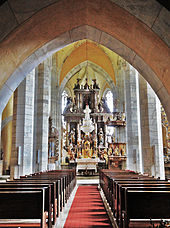Waitschach
Waitschach is a high-altitude place of pilgrimage in Carinthia with 24 inhabitants (January 1, 2020). Most of it belongs to the community of Guttaring , two buildings belong to the community of Hüttenberg . The parish and pilgrimage church of Maria Waitschach , located on a hilltop at an altitude of 1134 m, can be seen from afar . The place can be reached via Guttaring or a little closer from Hüttenberg. Both connecting roads are steep and winding. Waitschach has some mountain farms .
history
Leonhard von Keutschach is named as the initiator of the church , but there is also a legend that names an archbishop of Salzburg who made a pledge to build it. The pilgrimage church "Weytschach" is mentioned for the first time on November 2, 1390 as a branch of Guttaring. It is assumed, however, that a sanctuary must have existed at an earlier time, because the former baptismal font , a bowl stone in front of the church, dates from much older days. The sacred building had an essential function as a fortified church to protect against the Turkish threat . The fortifications are still clearly visible today, but are visibly deteriorating. The church itself and the Karner are constantly being restored.
church
Construction of the church began in 1447, as can be seen from the inscription on a north buttress. It presents itself as a five-axis late Gothic hall church with an eight-sided, roof turret-like tower. Characteristic of the sacred building in its figuration is its net , star and cross ribbed vaults .
Facility
The high altar , a two-story columned altar, is one of the oldest baroque altars in Austria. A crowned statue of the Madonna with a child in a halo stands in the shrine as a miraculous image. On both sides Maria's parents, Joachim on the left, Anna on the right, holding little Maria by the hand. To the left of the high altar, on the north side of the choir, there is a stone Gothic tabernacle . On the north wall of the nave there is a so-called "landscape altar" from 1626 with the depiction of the Annunciation . There is a painting of the Last Judgment on the south wall .
Karner
The Gothic charnel house dates from 1535. The interior is decorated with frescoes. The frescoes on the outer wall, including a sundial, are only remnants.
literature
- Martin Müller: Maria Waitschach - a contribution to the late Gothic sacral architecture of Carinthia. Diploma thesis at the University of Graz, 2001.
- Simon Poier: The pledge pilgrimage of the parish Judenburg to Maria Waitschach in synopsis with everyday experience, piety and popular piety. Dissertation at the University of Graz, 2002.
- Karl August Redlich: The manganese iron ore deposits of Waitschach in Carinthia. Montanistische Rundschau , Volume 16, No. 2, Vienna 1924, pp. 30–31.
- Heinz Meixner : New mineral finds from Austria XXX. In: Carinthia II . Volume 170/90, Klagenfurt 1980, pp. 40-42 (Chapter "278. The minerals from Waitschach near Hüttenberg", PDF on ZOBODAT ).
Web links
Individual evidence
- ↑ Statistics Austria: Population on January 1st, 2020 by locality (area status on January 1st, 2020) , ( CSV )
Coordinates: 46 ° 56 ' N , 14 ° 32' E











